| Proton Linac Development Division |
 |
|
|
Forming Facility for SCRF Cavities
A 120 ton capacity hydraulic press facility as an important infrastructure towards development of SCRF cavities has been set up at RRCAT, Indore. Being a hydraulic press, it offers an advantage of soft and jerk free forming of components. This facility is being regularly used for forming of components like half cells for 1.3 GHz and 650 MHz elliptical shaped SCRF cavities. It is also being used for forming of components of Single Spoke Resonator (SSR). In addition to this, it is also used for pull outs in beam tubes, helium vessel, spoke to shell collar etc. Fig. 1 shows 120 ton hydraulic press loaded with die and punch of 650 MHz cavity half-cell. Fig. 2, 3, 4 shows formed half cells, end wall of SSR and spoke of SSR respectively using the press facility.
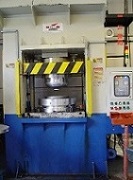
Fig.1: 120 ton capacity hydraulic press facility
|

Fig.2: Formed half cells of 650 MHz SCRF cavity
|
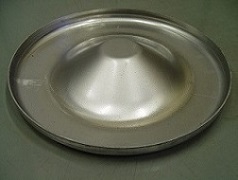
Fig.3: Formed end wall of Single Spoke Resonator (SSR)
|
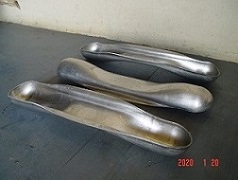
Fig.4: Formed spoke of SSR
|
Dimensional Inspection Facility for H- ion/Proton Accelerator Components
The different components of H- ion/Proton Accelerator, like Radio Frequency Quadrupole (RFQ), Drift Tube Linac (DTL), Single Spoke Resonator (SSR), Super Conducting RF (SCRF) cavities etc. are fabricated in very tight dimensional tolerances. It is mandatory to have dedicated co-ordinate measuring machine (CMM) to verify the dimensional tolerances during and after fabrication. For this, a large size high accuracy 3-D CNC CMM and a 7-axes portable arm CMM have been set up. Details of these CMMs are as follow:
I. Bridge type 3-D CNC CMM
A high accuracy 3-D CNC co-ordinate measuring machine facility has been set up by PLDD (Fig.5). This CMM is of bridge type with measuring sizes as X = 1,200 mm, Y = 2,000 mm and Z = 1,000 mm. CMM has the measuring accuracy of 1.6 + L/400 µm. A special temperature controlled and dust free enclosure has been built to house the CMM. CMM is equipped with a high precision scanning probe, touch trigger probe, laser scanning probe etc.
II. 7-axes Portable Arm CMM
A 7-axes type portable arm CMM has been installed and is being used at PLDD for dimensional inspection of accelerator components (Fig.6). This CMM has a spherical measuring volume of 2.5 m3 with volumetric accuracy of ± 0.038 mm with single point repeatability using ball probe as 0.027 mm. Arm CMM has in-built laser scanner. Laser scanner is being used for non contact type measurements. There is a dedicated software to prepare solid models from point cloud data.

Fig.5: 3-D CNC Co-ordinate Measuring Machine
|
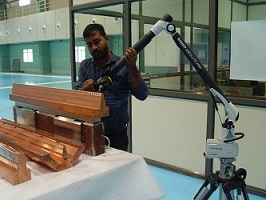
Fig.6: 7-Axes Portable Arm CMM.
|
Vacuum Leak Testing of Five cell 650 MHz Niobium SCRF cavities
Five cell 650 MHz Niobium SCRF cavity is designed to operate in cryogenic environment at liquid helium temperature typically at 2 K. Multi-cell cavity have multiple weld joints and is susceptible for weld inclusions during welding process. Inclusions may lead to leaks at room temperature or at cryogenic temperature. To ascertain vacuum integrity, it is necessary to carry out vacuum leak testing of fabricated cavity at room temperature as well as at cryogenic temperature. To carry out this, a dedicated infrastructure has been setup. Primarily, it needs a mass spectrometer leak detector (MSLD) capable of carrying out leak testing of multi-cell SCRF cavity. A large container to hold 500 liters of liquid nitrogen has been fabricated. It is a double walled thermally insulated vacuum vessel to minimize evaporation loss of liquid nitrogen. A special fixture to assemble and handle cavity was designed and fabricated.
To carry out vacuum leak testing of multi-cell SCRF cavity at room temperature (Fig. 7), it is assembled using rubber elastomer seals. After qualifying at room temperature, cavity flanges are sealed using aluminum diamond seal. Metal sealed cavity is dipped in liquid nitrogen and leak tested with helium mass spectrometer leak detector by purging He at bottom of the cryostat. After that assembled cavity is withdrawn from cryostat and put in polyethylene bag (Fig. 8) and filled with helium gas and leak tested using MSLD. In both cases Cavity has to qualify vacuum leak tightness with leak rates ≤ 5x10-12 mbar l/s.
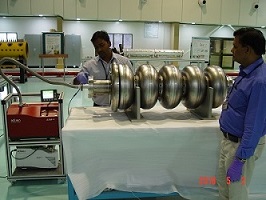
Fig.7: Vacuum leak testing of multi-cell SCRF cavity at room temperature
|
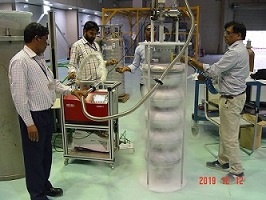
Fig.8: Vacuum leak testing of multi-cell cavity at liquid nitrogen temperature.
|
|
|
|
























